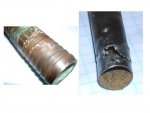junkhound
Senior Member
- Location
- Renton, WA
- Occupation
- EE, power electronics specialty
Had a Cu pipe leak after 44 years on a 1/2" type M pipe into a 3/4 to 1/2 T. Own house, so know the history. Well water, relatively soft but with some magnesium. Untreated.
Opened the plumbing T, saw 400 microamps 60Hz ground currents (FLuke 177). Ate a hole in the copper (RH photo), big area in the solder joint, enough of a metal difference also, was joined with 40/60 solder in 72.
Looks like the capacitance of the 10 AWG to water heater in 1/2" EMT was enough given the approx. 100 ft runs to drive the 400 uA.
Faraday equations show about the amount of copper plated to who knows where match the low current over about 5 or 6 years. I did replace one other copper pipe section with PEX about that long ago, may have redirected current thru this particular fitting. Installed a couple of external jumpers between Cu pipe and other nearby EMT.
Is there any NEC prohibition on external EMT jumper, never have noticed any?
The 3/4" bronze fitting was connecting HDPE within about 5 feet of the pad mounted 25kVa poco 5kV/240/120 transformer at my son's house. Only way I can see electrolysis there is soil (always wet, poco put transformer over a spring!) to bronze to slightly conductive water in pipe. Could be just the water district F and Cl added does it? Installed in 1992, leak found and coupling replaced in 2012. Have not tried to calculate any 5 kV leakage current thru the local WD water.
Anyone else found this type situation and done similar measurements and calculations ?
Luckily the T was on open basement ceiling. The coupling 4 years ago was a real difficult leak to find - just a drip, but water district has really high rates and showed up on water bill.

Opened the plumbing T, saw 400 microamps 60Hz ground currents (FLuke 177). Ate a hole in the copper (RH photo), big area in the solder joint, enough of a metal difference also, was joined with 40/60 solder in 72.
Looks like the capacitance of the 10 AWG to water heater in 1/2" EMT was enough given the approx. 100 ft runs to drive the 400 uA.
Faraday equations show about the amount of copper plated to who knows where match the low current over about 5 or 6 years. I did replace one other copper pipe section with PEX about that long ago, may have redirected current thru this particular fitting. Installed a couple of external jumpers between Cu pipe and other nearby EMT.
Is there any NEC prohibition on external EMT jumper, never have noticed any?
The 3/4" bronze fitting was connecting HDPE within about 5 feet of the pad mounted 25kVa poco 5kV/240/120 transformer at my son's house. Only way I can see electrolysis there is soil (always wet, poco put transformer over a spring!) to bronze to slightly conductive water in pipe. Could be just the water district F and Cl added does it? Installed in 1992, leak found and coupling replaced in 2012. Have not tried to calculate any 5 kV leakage current thru the local WD water.
Anyone else found this type situation and done similar measurements and calculations ?
Luckily the T was on open basement ceiling. The coupling 4 years ago was a real difficult leak to find - just a drip, but water district has really high rates and showed up on water bill.

